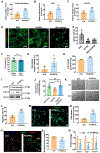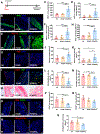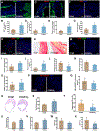Rescuing Cardiac Cells and Improving Cardiac Function by Targeted Delivery of Oxygen-Releasing Nanoparticles after or Even before Acute Myocardial Infarction
- PMID: 36367231
- PMCID: PMC9930176
- DOI: 10.1021/acsnano.2c10043
Rescuing Cardiac Cells and Improving Cardiac Function by Targeted Delivery of Oxygen-Releasing Nanoparticles after or Even before Acute Myocardial Infarction
Abstract
Myocardial infarction (MI) causes massive cell death due to restricted blood flow and oxygen deficiency. Rapid and sustained oxygen delivery following MI rescues cardiac cells and restores cardiac function. However, current oxygen-generating materials cannot be administered during acute MI stage without direct injection or suturing methods, both of which risk rupturing weakened heart tissue. Here, we present infarcted heart-targeting, oxygen-releasing nanoparticles capable of being delivered by intravenous injection at acute MI stage, and specifically accumulating in the infarcted heart. The nanoparticles can also be delivered before MI, then gather at the injured area after MI. We demonstrate that the nanoparticles, delivered either pre-MI or post-MI, enhance cardiac cell survival, stimulate angiogenesis, and suppress fibrosis without inducing substantial inflammation and reactive oxygen species overproduction. Our findings demonstrate that oxygen-delivering nanoparticles can provide a nonpharmacological solution to rescue the infarcted heart during acute MI and preserve heart function.
Keywords: acute myocardial infarction; controlled release of oxygen; myocardial repair; nanoparticles; targeted delivery.
Conflict of interest statement
The authors declare no competing financial interest.
Figures








Similar articles
-
Targeted Anti-Inflammatory Nanozymes with Pro-Angiogenic Activity for Myocardial Infarction Therapy.Adv Healthc Mater. 2025 May;14(14):e2404979. doi: 10.1002/adhm.202404979. Epub 2025 Apr 30. Adv Healthc Mater. 2025. PMID: 40304163
-
An Injectable Oxygen Release System to Augment Cell Survival and Promote Cardiac Repair Following Myocardial Infarction.Sci Rep. 2018 Jan 22;8(1):1371. doi: 10.1038/s41598-018-19906-w. Sci Rep. 2018. PMID: 29358595 Free PMC article.
-
Carvedilol and thyroid hormones co-administration mitigates oxidative stress and improves cardiac function after acute myocardial infarction.Eur J Pharmacol. 2019 Jul 5;854:159-166. doi: 10.1016/j.ejphar.2019.04.024. Epub 2019 Apr 13. Eur J Pharmacol. 2019. PMID: 30991047
-
Clinical aspects of left ventricular diastolic function assessed by Doppler echocardiography following acute myocardial infarction.Dan Med Bull. 2001 Nov;48(4):199-210. Dan Med Bull. 2001. PMID: 11767125 Review.
-
Angiogenesis after acute myocardial infarction.Cardiovasc Res. 2021 Apr 23;117(5):1257-1273. doi: 10.1093/cvr/cvaa287. Cardiovasc Res. 2021. PMID: 33063086 Review.
Cited by
-
Nanosystems in Cardiovascular Medicine: Advancements, Applications, and Future Perspectives.Pharmaceutics. 2023 Jul 12;15(7):1935. doi: 10.3390/pharmaceutics15071935. Pharmaceutics. 2023. PMID: 37514121 Free PMC article. Review.
-
Cell Reprogramming, Transdifferentiation, and Dedifferentiation Approaches for Heart Repair.Int J Mol Sci. 2025 Mar 27;26(7):3063. doi: 10.3390/ijms26073063. Int J Mol Sci. 2025. PMID: 40243729 Free PMC article. Review.
-
Targeted delivery of engineered adipose-derived stem cell secretome to promote cardiac repair after myocardial infarction.J Control Release. 2025 Jul 10;383:113765. doi: 10.1016/j.jconrel.2025.113765. Epub 2025 Apr 22. J Control Release. 2025. PMID: 40274072 Free PMC article.
-
Propensity score analysis of red cell distribution width to serum calcium ratio in acute myocardial infarction as a predictor of in-hospital mortality.Front Cardiovasc Med. 2023 Dec 19;10:1292153. doi: 10.3389/fcvm.2023.1292153. eCollection 2023. Front Cardiovasc Med. 2023. PMID: 38169646 Free PMC article.
-
Nanomedicine-Based Therapeutics for Myocardial Ischemic/Reperfusion Injury.Adv Healthc Mater. 2023 Aug;12(20):e2300161. doi: 10.1002/adhm.202300161. Epub 2023 Apr 10. Adv Healthc Mater. 2023. PMID: 36971662 Free PMC article. Review.
References
-
- Fryar CD; Chen T-C; Li X Prevalence of uncontrolled risk factors for cardiovascular disease: United States, 1999–2010. NCHS Data Br. 2012, 103, 1–8. - PubMed
-
- Shuvy M; Atar D; Gabriel Steg P; Halvorsen S; Jolly S; Yusuf S; Lotan C Oxygen therapy in acute coronary syndrome: are the benefits worth the risk? Eur. Heart J 2013, 34 (22), 1630–1635. - PubMed
Publication types
MeSH terms
Substances
Grants and funding
LinkOut - more resources
Full Text Sources
Medical

